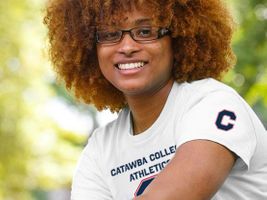If Catawba students find the '14-'15 Student Handbook easier to navigate and understand, they can thank some of their peers for taking on the task of making it more student-friendly.
Students in Dr. Margy Stahr's spring semester Professional and Technical Writing class took on that task as well as the task of revising several other handbooks used on campus, including the Tutoring Manual for Academic Support Services, the Social Media Manual for Athletics, and the Study Abroad Faculty Handbook. These assignments allowed Stahr's students, who worked in small groups, to "practice working on large-scale projects."
Katelin Rice of Thomasville, a member of one group that tackled a portion of the Student Handbook, said, "We felt it was important from a student's point of view that it be accessible and easily understood. We tried to simplify portions of it, but found it was hard to simplify while maintaining a level of professionalism."
Danielle Bunten of Southport and Timberley Motsinger of Winston-Salem also tackled sections of the Student Handbook concerning clubs and organizations on campus. They found that some clubs, especially new ones, were not included in the handbook and "devised a structure," Motsinger said, that "kept one club from overpowering another."
"We included what each club does, what its activities are, and how to become a member for each," Motsinger continued.
Shepard
Theo Shepard of Southport and his group worked on the Tutoring Manual, a handbook they created from different resources provided to them by staff members in Academic Support Services. "We had to decide what was most useful," Shepard said. "Even the forms needed some revision and reconstruction – such as the Request for a Tutor and the Application to Be a Tutor forms."
Shepard's group also created a Tutor Communications Sheet that will allow the tutors to report on their sessions with tutees in specific courses.
"We tried to condense the request for a tutor and the application to be a tutor," Darby Reedy added. "Both became one-sheeters."
Catawba's Director of Initiatives for Student Success Andie Lynch was appreciative of the work Stahr's students put into creating the Tutoring Manual. "I love the fact that we can utilize our students to help us improve our current documents and processes. They are the benefactors of these services so it only make sense to gather their input all while putting their education to use," Lynch said. "I also enjoyed getting to work closely with these students in a different capacity and I look forward to future projects such as these with our students."
Shakeisha Gray of Salisbury, whose group worked on the Faculty Study Abroad Handbook, said the goal was to "make the voice more approachable and not so technical."
Barbee
Katie Barbee of Salisbury said her group focused on updating the Twitter guidelines in the Social Media Manual for Athletics. Andrew McCollister of Rockwell, a member of her group, noted that the attempt was to "keep the language professional while spreading the love" for the team or the sport.
"Social media can be difficult balancing the professional side of business with the conversational style of use," explained David McDowell, Catawba's Director of Athletic Marketing and Assistant Sports Information Director. "The students involved in this project did a wonderful job merging these two styles and creating a foundation in the Social Media Manual for our department to build upon."
Sidney Smith of Salisbury summed up the work she and her classmates did on the handbooks as "an interesting experience."
Smith said of her group's work on the Student Handbook, "I think the product we created is better than what we started with."
Professor Stahr agreed. "The students and I learned that any time you have a manual or a handbook that many people have contributed to over a number of years, the message is likely to become muddy. At some point, new readers have to look at these documents and say, ‘This still works well, but I can improve the clarity of this section.' "
Class Also Delves Into Professional Communications
Stahr's students were also assigned the task of interviewing local professionals, including an attorney, a business owner, a dentist, an educator, and a writer, about how they use writing in their professions.
Stahr
Stahr explained, "The most important thing to me about this project is that it required students to not only engage in professional forms of communication, but to actually act in a professional way."
The students mailed formal inquiry letters to their chosen professionals, followed these letters up with professional phone calls, and then made an oral presentation with a visual aid about what they learned by interviewing these professionals.
Student Sydney Smith interviewed a local teacher who told her that "lazy English is hurting communication," although the teacher noted the positive and negative effects of social media and other forms of technical communication. The teacher used emails to communicate with parents and her fellow teachers, Smith said, and emphasized the need for documenting information. This teacher also used Facebook and other social media platforms to keep in touch with former students.
A professional photographer was who student Leah Thompson of Salisbury chose to interview. The photographer's primary forms of communication were e-mails, advertising and blogging via social media platforms. Thompson said she learned that "a lot of clients means a lot of communication."
Student Andrew McCollister, who aspires to be a dentist, interviewed a local dentist. He learned that the dentist engages in three different types of communication: communication with patients, inter-office communication, and company communication. The need for clarity and conciseness, McCollister said, were stressed by the dentist.
McCollister summed up what he and his classmates learned during the process of delving into professional communications: "All of us agree that knowing the audience for your communication is key."
